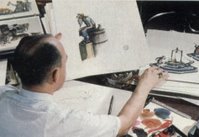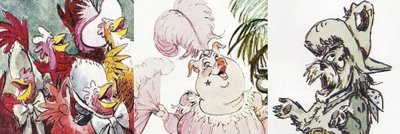
America Sings
“Yankee Doodle remembers when
To make these songs ring true
People came from every land
To mix these tunes for you.
So we should all remember
As history moves along
That everything is better now
For someone wrote a song!”
The next Marc Davis venture was to be a fateful one, not only for being the first Disneyland attraction to be done more or less without the supervision of Walt Disney in some form (even the new Mickey Mouse Revue and Hall of Presidents attractions over at Walt Disney World were outgrowths of Disney-originated ideas), but a fateful foray into a world of “them e parks” that was teetering precariously on the razor’s-edge of complete upheaval. Since the opening of
e parks” that was teetering precariously on the razor’s-edge of complete upheaval. Since the opening of
In effect, it would be an old-fashioned Disney-style show on a grand scale when, all around the
And in the midst of all this 70’s hedonism, the bicentennial of  ntry Bear Jamboree and
ntry Bear Jamboree and
The show would be wedged (literally) into the Carousel of Progress theatre, making it an uneasy fit in Tomorrowland and requiring something of the clever manipulation that Claude Coates utilized when he designed If You Had Wings, another slightly awkward fit in another Tomorrowland: finally emphasizing a vaguely suggested but positive “future” of (aviation, air travel, song, etc). But the show was a technical marvel, far outpacing the simple revolving platforms of the Bear show by flying in and out literally dozens of figures on hydraulic lifts. Stages rotate in and out of view, figures fly up and down, back and forth, and whole walls peel away to reveal new levels and layers.
Of course all of this is augmented by the fact that the stage itself stays still and the audience moves from set to set, w hich ultimately becomes the structuring motif of the show itself: because the scene is constantly changing, to build a sense of continuity Davis and Bertino built in a succession of repetitions which continue both within and outside of each “act”, with each act as an entire self-contained unit with its’ own patterns and variations.
hich ultimately becomes the structuring motif of the show itself: because the scene is constantly changing, to build a sense of continuity Davis and Bertino built in a succession of repetitions which continue both within and outside of each “act”, with each act as an entire self-contained unit with its’ own patterns and variations.
The biggest and most brilliant pattern is the cleverly re-written verses of Yankee Doodle Dandy,
What these repetitions actually do, combined with the relentless onward turning of the carousel in exactly even units of time (for each act must run exactly the same length), is create patterns of setup and payoff – namely, expectation – which the show builds on for entertainment and comedy. This concept is actually an expansion of the “honk honk” created by baby bear Oscar squeezing his teddy bear in Country Bear Jamboree at the conclusion of each number by the Five Bear Rugs. Oscar squeezes his teddy three times in Country Bears, and each time it’s a laugh. In America Sings, the audience is tormented by that weasel seven times, the payoff being his final signing off of “Goodbye, goes the weasel!”
But the weasel structures the acts in a fairly complex way, often signaling a shift in rhythm and to ne; between “The Birmingham Jail” and “Down By the Riverside”, between “Who Shot the Hole in My Sombrero?” and “The Tale of Billy the Kid”, and more. In the Gay Ninties segment he actually appears twice, once to downshift the exuberance of the showgirl pig’s rendition of “Bill Bailey, Won’t You Please Come Home?” to the more restrained accapella version of “Sweet Adeline” by the four geese and Blossom-Nose Murphy. Furthermore, the weasel’s interruptions are often followed by commentary by Sam and Ollie in a more leisurely fashion than the pace of the show can usually accommodate in the heat of the battle switching between songs.
ne; between “The Birmingham Jail” and “Down By the Riverside”, between “Who Shot the Hole in My Sombrero?” and “The Tale of Billy the Kid”, and more. In the Gay Ninties segment he actually appears twice, once to downshift the exuberance of the showgirl pig’s rendition of “Bill Bailey, Won’t You Please Come Home?” to the more restrained accapella version of “Sweet Adeline” by the four geese and Blossom-Nose Murphy. Furthermore, the weasel’s interruptions are often followed by commentary by Sam and Ollie in a more leisurely fashion than the pace of the show can usually accommodate in the heat of the battle switching between songs.
He appears once more at the very end of the Gay Ninties segment, drunk, which is not only a structural payoff (he never again appears twice), but a linking “effect” and nestled right before another linking “effect” which itself structures the act and makes it unique: two descending cords played on a piano, which play immediately after the conclusion of “Home on the Range” and “Tah-Ra-Ra-Boom-De-Ay”. And since “Tah-Ra-Ra” is so repetitive, and because it is followed by three more repetitions / variations on existing patterns (“Pop, goes the weasel! Hic!” / two descending chords / Yankee Doodle Dandy), the audience is suddenly confronted with four repetitions in less than ten seconds. The whole pace of the show suddenly “shifts up” to the manic pace required by the Modern Times act, featuring eleven songs at breakneck pace, the most of any act in the show (it averages around eight). The show structurally has increased the pace the necessary amount simply by repeating four elements in an intelligent and designed fashion.
The primary fulfillment of America Sings and Country Bear Jamboree is, in effect, structural.
 America Sings also extends the concept of the narrator or master of ceremonies as presented in Disney attractions of the era. It’s important to differentiate between the pre-1963
America Sings also extends the concept of the narrator or master of ceremonies as presented in Disney attractions of the era. It’s important to differentiate between the pre-1963  .
.
The show also represented two other significant benchmarks in the history of
America Sings is a complex give and take, constantly setting up expectations and then defeating them only to set up further expectations; engaging the audience on a deep level, effectively getting us “where we live” - our desire to be entertained doesn’t mean we have to shut our brains off, either. Consider the opening moments where, an audience prepared to see an Audio-Animatronics review, hears a fanfare and sees a curtain open to reveal – two figures standing shock still. And they remain still, despite Ollie’s occasional blinking, through a fairly leisurely passage of “Yankee Doodle Dandy”, whereupon Sam the Eagle starts moving like greased lightning. This is a reformation of the audience’s “contract” with the show, providing audio animatronics figures but not requiring them to actually move. This is a reversal of the opening of the Country Bear Jamboree, where the animation is sudden and unexpected. Here, the gratification of animation is presented, but delayed.

The way the show will raise and lower characters into view, have them slide in and out of sight, and then shuffle the audience ever onward is part of this give and take: which of course comes to a head at the end of the Gay Ninties segment, where first a tiny portion of the set opens to allow the “Bird in the Gilded Cage” to slide forward, then the entire back wall peels away to reveal an entire chorus line of chicken showgirls, two storks riding unicycles, and a drunk pig waiter. The climax of the Going West segment has the scrim “sky” suddenly become transparent to reveal more hidden figures. Perhaps best and most interestingly of all, two featured performers aren’t hidden or flown in at all: the “Boot Hill Boys” are present on set of Act Two for its’ entire duration, only performing their number in the last third of the presentation.
The Boot Hill Boys are, of course, perhaps the best indication of  simply ‘move a figure’. Their movements, appealingly simple, were more or less restricted to head raise, head turn, and beak open, but
simply ‘move a figure’. Their movements, appealingly simple, were more or less restricted to head raise, head turn, and beak open, but
Yet after all is said and done, the Country Bears and America Sings could not be more similar, nor much more different. Both are, unmistakably, Marc Davis presentations and, for much of the history of
Yet America Sings, brilliantly and fully realized, teetering on the edge of a culture about to go Coaster Crazy, ironically, was the first and last Disney attraction to go for the full spectrum of emotions. After years of refinement, work, and discovery, America Sings seems to be WED’s moment to stand up and say “look what we can do”. As the first Disney attraction to go for and earn poignancy honestly, simply, and smartly, it’s hard for me to improve on the final lyrics of the show, one of the most famous popular American songs, so let these be a fitting close.
“Yankee Doodle always says
The past is just the start
Tomorrow will bring songs to you
That come straight from the heart.
Another thing he had to say,
Is life, is just a song
So everybody get in tune
And let’s all sing along!
Should auld acquaintance be forgot
And never brought to mind
Should auld acquaintance be forgot
And days of auld lang syne...”






